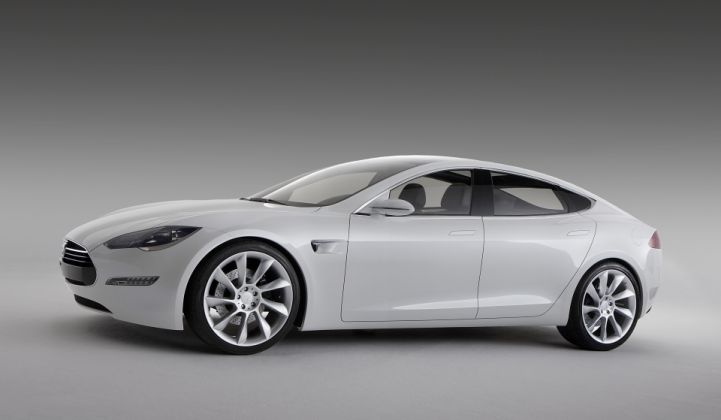For sheer audacity, Tesla wins.
Transitioning from a few megalomaniacal entrepreneurs and investors armed with a PowerPoint to a public company with a shipment record and ownership of a few million feet of factory space is an absolutely breathtaking feat, by any standard.
The firm is now confronted by an arguably even bigger set of challenges: moving from being a boutique luxury supplier to a mass production company.
In a first for the firm, Tesla gave a peek inside their engineering and manufacturing operations, newly located in a sleek 370,000-square-foot facility in Palo Alto, California. Tesla escorted a score of automotive and greentech press people through their drivetrain, battery and test labs. It's good PR timing for the firm, considering their recent speed bumps. In any case, no pictures were allowed, due to the sensitive nature of the activities that take place on the factory floor.
Building a manufacturing facility in the middle of Silicon Valley despite the sticker shock of living and working in the San Francisco Bay Area seems to be another manifestation of the Tesla contrarian mindset.
The Factory Floor
Most striking about the battery and drivetrain assembly area is the fact that it's clean, open and well lit. The (non-union) employees are all dressed in Tesla-wear and seem focused and driven. And perhaps more striking is that Tesla seems to be bringing automotive manufacturing back to the United States.
Batteries, Battery Testing, Battery Safety
Tesla has shipped about 1,300 Roadsters and has logged about seven million vehicle-miles and 14 million hours of cell test data. All of that battery data is gathered at their battery labs and analyzed in detail. Most every reputable company that makes a lithium-ion 18650 form-factor cell has sent them to Tesla for testing -- and Tesla puts them through their paces. Almost all of the cells originate from Japan, with a few from Korea and China -- there's not a single American company on the list.
Tesla claims that they possess the most advanced cell testing lab in the world. The firm also claims that the energy density of their battery packs far exceeds that of their EV competitors, at about 130 watt-hours per kilogram.
With regards to battery safety, there is an enormous amount of redundancy built into the battery pack. The firm has made efforts to eliminate the risk of thermal runaway. If a thermal runaway event does occur, the battery pack design incorporates multiple levels of fusing to ensure that it does not propagate. The sheer amount of battery testing done by this firm is impressive and has essentially made Tesla one of the leaders in battery reliability and blowing up batteries. The company showed video of the vehicle and its battery being crushed and engulfed in flames in a variety of different scenarios and conditions.
My naive non-automotive-engineer question would be to ask why a battery form factor used for laptops and toys is still being re-purposed for a luxury vehicle. It turns out that Tesla is buying custom battery cells for their pack, and Jim Dunlay, VP of Powertrain Hardware Engineering, insists that the volume-production of the 18650 form-factor has helped bring cost down and improve design.
Making the Model S
Roadster production is going to end sometime about 2012. The future of the Tesla brand and company lies in the Model S Sedan (pictured above.)
Peter Rawlinson, VP and Chief Engineer for Vehicle Engineering, spoke of moving from the Roadster to the Sedan and competing against the leading names in the automotive world, like "Lexus and Audi." Tesla has some advantages -- the flat bottom of the battery pack (the "perfectly flat underbelly," in Rawlinson's words) allows for a different level of aerodynamics and reduced drag. Tesla has recruited aerodynamicists from Formula One, as well as the wizards of Maranello's Ferrari's Formula One team.
There are more cells in the Tesla Model S than in the Roadster but the EV allows for more room for passenger leg room, storage and crumple space because of the architecture of the battery back.
Tesla wants to beat the best cars out there, so they've designed new front and rear suspensions especially for electric vehicles. They've recruited from Lotus for their Model S platform. And they've spent an enormous amount of effort on body structure and safety to go with their 300-mile driving range.
Rawlinson spoke a bit about Better Place. Since the Tesla battery pack is an integral part of the structure of the car, they don't have the same vision of battery-swapping. "You cannot think of the battery pack as isolated from the design of the car." said Rawlinson. Battery vendors for the S Model have not yet been chosen.
Tesla is Hiring
Tesla currently employs about 700 people and they're hiring, looking to bring up to 2,000 people in the not-so-long-term. And looking to hire smart people, not necessarily just those with automotive experience. The firm is hiring and growing very rapidly, looking for key personnel in virtually every area for their model S development.
In case you're wondering, Tesla employees do not receive a discount on a Tesla purchase.



